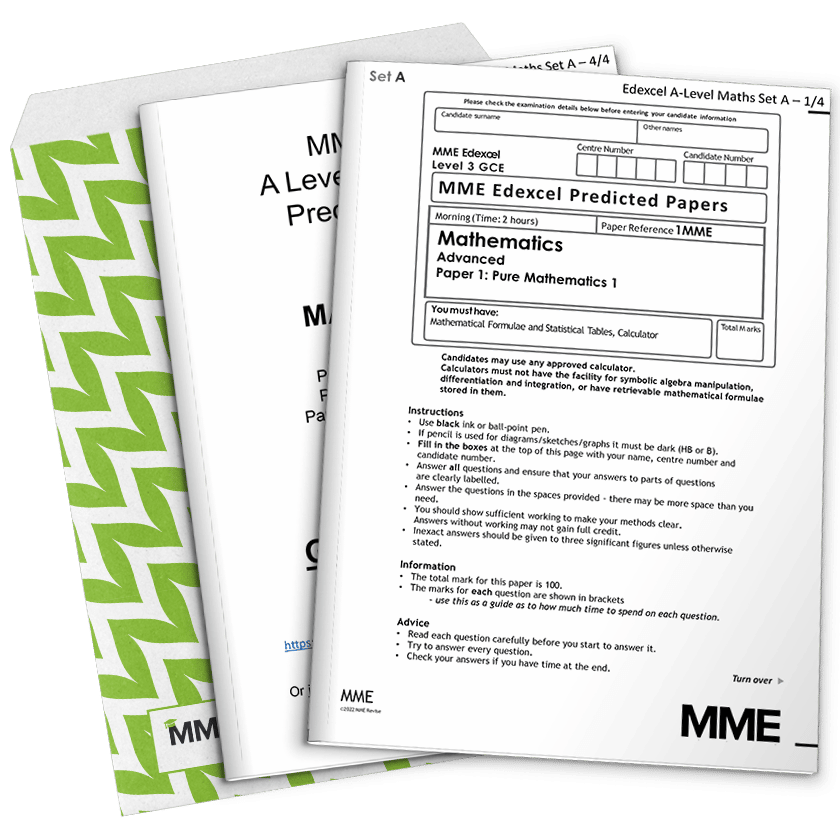Partial Fractions
Partial Fractions Revision
Partial Fractions
Algebraic fractions that have a denominator with more than one linear factor can be split, or decomposed, into partial fractions. This can be particularly useful when integrating complex expressions or with binomial expansions.
Questions involving partial fractions will only ever involve a numerator that is a constant or a linear term and the denominator will only ever include up to three terms with the most complex being squared linear terms.
Types of Partial Fraction
There are 3 types of partial fraction that you will see in A level Maths:
1. Considering a fraction where the denominator has two linear terms, we can split up the fraction into two separate fractions,
\dfrac{5}{\textcolor{limegreen}{(x+1)} \textcolor{blue}{(x+2)}} can be split up into \dfrac{A}{\textcolor{limegreen}{(x+1)}}+\dfrac{B}{\textcolor{blue}{(x+2)}}
2. Considering a fraction where the denominator has three linear terms, we can split up the fraction into three separate fractions,
\dfrac{3x+4}{\textcolor{limegreen}{(x+1)}\textcolor{blue}{(x+2)}\textcolor{orange}{(x-1)}} can be split up into \dfrac{A}{\textcolor{limegreen}{(x+1)}}+\dfrac{B}{\textcolor{blue}{(x+2)}} +\dfrac{C}{\textcolor{orange}{(x-1)}}
3. Considering a fraction where the denominator has one linear term and a repeated term, we can split up the fraction into three separate fractions,
\dfrac{2x+1}{{\textcolor{limegreen}{(x+1)}}^2 \textcolor{blue}{(x+2)}} can be split up into \dfrac{A}{{\textcolor{limegreen}{(x+1)}}^2}+\dfrac{B}{\textcolor{limegreen}{(x+1)}} +\dfrac{C}{\textcolor{blue}{(x+2)}}
Expressing Fractions as Partial Fractions
To find the coefficients in the numerators in the partial fractions, A, B and C, there are 2 different methods you can use: Substitution or Equating Coefficients.
Example: Express \dfrac{5x+1}{(x-1)(x+1)(x+2)} as partial fractions.
Step 1: Write the fraction as partial fractions with unknown constants, and put it over a common denominator:
\begin{aligned} \dfrac{5x+1}{(x-1)(x+1)(x+2)} &\equiv \dfrac{A}{(x-1)} + \dfrac{B}{(x+1)} + \dfrac{C}{(x+2)} \\[1.2em] &\equiv \dfrac{A(x+1)(x+2) + B(x-1)(x+2) + C(x-1)(x+1)}{(x-1)(x+1)(x+2)} \end{aligned}
Step 2: Cancel down the denominators:
5x+1 \equiv A(x+1)(x+2) + B(x-1)(x+2) + C(x-1)(x+1)
Step 3: Use the Substitution or Equating Coefficients to find the values of the unknown constants, A, B and C:
Substitution:
Substitute values of x inside the brackets to make them 0, so that you are left with only one of A, B and C:
Substitute in x = 1:
\begin{aligned} 5(1) + 1 &= A(1+1)(1+2) \\ 6 &= 6A \\ \textcolor{red}{A} &\textcolor{red}{=} \textcolor{red}{1} \end{aligned}
Substitute in x = -1:
\begin{aligned} 5(-1) + 1 &= B(-1-1)(-1+2) \\ -4 &= -2B \\ \textcolor{blue}{B} &\textcolor{blue}{=} \textcolor{blue}{2} \end{aligned}
Substitute in x = -2:
\begin{aligned} 5(-2) + 1 &= C(-2-1)(-2+1) \\ -9 &= 3C \\ \textcolor{limegreen}{C} &\textcolor{limegreen}{=} \textcolor{limegreen}{-3} \end{aligned}
Equating Coefficients:
Equate coefficients and then solve them simultaneously to find the values of the unknown constants, A, B and C:
5x+1 \equiv A(x+1)(x+2) + B(x-1)(x+2) + C(x-1)(x+1)
\equiv A(x^2 + 3x + 2) + B(x^2 + x - 2) + C(x^2 - 1)
\equiv (A + B + C)x^2 + (3A + B)x + (2A - 2B - C)
Equating x^2 coefficients gives:
0 = A + B + C
Equating x coefficients gives:
5 = 3A + B
Equating constant terms gives:
1 = 2A - 2B - C
Then, solve these simultaneously, which gives \textcolor{red}{A = 1}, \textcolor{blue}{B = 2} and \textcolor{limegreen}{C = -3}
Step 4: Replace the constant terms, A, B and C in the original identity:
\dfrac{5x+1}{(x-1)(x+1)(x+2)} \equiv \dfrac{\textcolor{red}{1}}{(x-1)} + \dfrac{\textcolor{blue}{2}}{(x+1)} \textcolor{limegreen}{-} \dfrac{\textcolor{limegreen}{3}}{(x+2)}
Note: The unknown constants may not always be this nice – you may get questions with constant terms that are fractions.
Note:
- You may need to combine the methods of Substitution and Equating Coefficients for some examples, such as fractions with repeated terms.
- You may be given a fraction that is not split up into brackets in the denominator, so you will need to factorise it. Also, look out for the difference of two squares.
Example: Repeated Terms
Express \dfrac{2x-3}{x(x-2)^2} as partial fractions.
[3 marks]
Write the fraction as partial fractions with unknown constants, and put it over a common denominator:
\begin{aligned} \dfrac{2x-3}{x(x-2)^2} &\equiv \dfrac{A}{(x-2)^2} + \dfrac{B}{x-2} + \dfrac{C}{x} \\[1.1em] &\equiv \dfrac{Ax + Bx(x-2) + C(x-2)^2}{x(x-2)^2} \end{aligned}
Then, cancel the denominators:
2x-3 \equiv Ax + Bx(x-2) + C(x-2)^2
Substitute in x=0:
\begin{aligned} -3 &= C(-2)^2 \\ C &= - \dfrac{3}{4} \end{aligned}
Substitute in x=2:
\begin{aligned} 2(2) - 3 &= 2A \\ A &= \dfrac{1}{2} \end{aligned}
Now, equate coefficients of x^2:
\begin{aligned} 0 &= B + C \\ B &= \dfrac{3}{4} \end{aligned}
Finally, replace the values of A, B and C into the original identity:
\dfrac{2x-3}{x(x-2)^2} \equiv \dfrac{1}{2(x-2)^2} + \dfrac{3}{4(x-2)} - \dfrac{3}{4x}
Partial Fractions Example Questions
Question 1: Express \dfrac{8}{9x^2 - 16} as partial fractions.
[3 marks]
\dfrac{8}{9x^2 - 16} = \dfrac{8}{(3x+4)(3x-4)}
\begin{aligned} \dfrac{8}{(3x+4)(3x-4)} &\equiv \dfrac{A}{(3x+4)} + \dfrac{B}{(3x-4)} \\[1.1em] &\equiv \dfrac{A(3x-4) + B(3x+4)}{(3x+4)(3x-4)} \end{aligned}
8 \equiv A(3x-4) + B(3x+4)
Substitute in x=\dfrac{4}{3}:
\begin{aligned} 8 &= 8B \\ B &= 1 \end{aligned}
Substitute in x=- \dfrac{4}{3}:
\begin{aligned} 8 &= -8A \\ A &= -1 \end{aligned}
Then, replace the values of A and B into the identity:
\dfrac{8}{9x^2 - 16} \equiv - \dfrac{1}{(3x+4)} + \dfrac{1}{(3x-4)}
Question 2: Express \dfrac{x}{(x-1)(x-2)(x-3)} as partial fractions.
[3 marks]
\dfrac{x}{(x-1)(x-2)(x-3)} \equiv \dfrac{A}{(x-1)} + \dfrac{B}{(x-2)} + \dfrac{C}{(x-3)}
\equiv \dfrac{A(x-2)(x-3) + B(x-1)(x-3) + C(x-1)(x-2)}{(x-1)(x-2)(x-3)}
x = A(x-2)(x-3) + B(x-1)(x-3) + C(x-1)(x-2)
Substitute in x = 1:
\begin{aligned} 1 &= A(1-2)(1-3) \\ A &= \dfrac{1}{2} \end{aligned}
Substitute in x = 2:
\begin{aligned} 2 &= B(2-1)(2-3) \\ B &= -2 \end{aligned}
Substitute in x = 3:
\begin{aligned} 3 &= C(3-1)(3-2) \\ C &= \dfrac{3}{2} \end{aligned}
Then, replace the values of A, B and C into the identity:
\dfrac{x}{(x-1)(x-2)(x-3)} \equiv \dfrac{1}{2(x-1)} - \dfrac{2}{(x-2)} + \dfrac{3}{2(x-3)}
Question 3: Express \dfrac{10}{x^2(x+1)} as partial fractions.
[3 marks]
10 \equiv A(x+1) + Bx(x+1) + Cx^2
Substitute in x = 0:
\begin{aligned} 10 &= A(0+1) \\ A &= 10 \end{aligned}
Substitute in x = -1:
\begin{aligned} 10 &= C(-1)^2 \\ C &= 10 \end{aligned}
Equate coefficients of x^2:
\begin{aligned} 0 &= B + C \\ B &= -10 \end{aligned}
Then, replace the values of A, B and C into the identity:
\dfrac{10}{x^2(x+1)} \equiv \dfrac{10}{x^2} - \dfrac{10}{x} + \dfrac{10}{(x+1)}
You May Also Like...

MME Learning Portal
Online exams, practice questions and revision videos for every GCSE level 9-1 topic! No fees, no trial period, just totally free access to the UK’s best GCSE maths revision platform.






